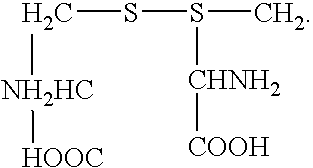Skin, scalp and hair treatment compositions and methods
a technology for scalp and hair, applied in the field of skin and hair treatment, can solve the problems of excessive dryness, irritation of eyes or even skin, and undetectable oily residue on the body, and achieve the effect of increasing the longevity of the effect and long-lasting
- Summary
- Abstract
- Description
- Claims
- Application Information
AI Technical Summary
Benefits of technology
Problems solved by technology
Method used
Image
Examples
example 1a
The composition reported under column A in Table 1 is prepared. In particular, a liquid dye base comprising dye intermediate, carrier and maintaining agent consisting of D-glucose and sucrose in 1:2 weight ratio is prepared in accordance with the composition indicated in Table 2. The composition described in Table 2 consists of about 1.0 parts by weight (PBW) of oxidative dyeing agent, about 97 PBW of carrier and about 2 PBW of maintaining agent. The dye intermediate is described in Table 3.
A bleach booster powder consisting of about 36 PBW of potassium persulfate, about 21 PBW of ammonium persulfate, about 36 PBW silica thickening agent, about 5 PBW of carboxymethylcellulose (CMC-7H3SF), about 1 PBW of fumed silica (CAB-O-SIL M5), and about 1 PBW of chelating agent (Hamp-ene acid) is prepared.
A developer (oxidizing agent) for the dye intermediate GB comprising a 3 percent by weight solution of hydrogen peroxide is provided. The developer thus comprises about 3 PBW of active co...
example 1b
The composition reported under column B in Table 1 is prepared. In particular, a liquid dye base comprising dye intermediate, carrier and maintaining agent as in Example 1A is prepared in accordance with the composition indicated in Table 2. The composition described in Table 2 consists of about 1.0 parts by weight (PBW) of oxidative dyeing agent, about 97 PBW of carrier and about 2 PBW of maintaining agent. The dye intermediate is described in Table 3.
A bleach booster powder consisting of about 36 PBW of potassium persulfate, about 21 PBW of ammonium persulfate, about 36 PBW silica thickening agent, about 5 PBW of carboxymethylcellulose (CMC-7H3SF), about 1 PBW of fumed silica (CAB-O-SIL M5), and about 1 PBW of chelating agent (Hamp-ene acid) is prepared.
A developer (oxidizing agent) for the dye intermediate GB comprising a 3 percent by weight solution of hydrogen peroxide is provided. The developer thus comprises about 3 PBW of active coloring compound and about 97 PBW of car...
example 1c
The composition reported under column C in Table 1 is prepared. In particular, a liquid dye base comprising dye intermediate, carrier and maintaining agent is prepared in accordance with the composition indicated in Table 2. The composition described in Table 2 consists of about 1.0 parts by weight (PBW) of oxidative dyeing agent, about 97 PBW of carrier and about 2 PBW of glucose. The dye intermediate is described in Table 3.
A bleach booster powder consisting of about 36 PBW of potassium persulfate, about 21 PBW of ammonium persulfate, about 36 PBW silica thickening agent, about 5 PBW of carboxymethylcellulose (CMC-7H3SF), about 1 PBW of fumed silica (CAB-O-SIL M5), and about 1 PBW of chelating agent (Hamp-ene acid) is prepared.
A developer (oxidizing agent) for the dye intermediate GB comprising a 12 percent by weight solution of hydrogen peroxide is provided. The developer thus comprises about 12 PBW of active coloring compound and about 88 PBW of carrier.
A coloring composi...
PUM
| Property | Measurement | Unit |
|---|---|---|
| weight ratio | aaaaa | aaaaa |
| composition | aaaaa | aaaaa |
| weight | aaaaa | aaaaa |
Abstract
Description
Claims
Application Information
 Login to View More
Login to View More - R&D
- Intellectual Property
- Life Sciences
- Materials
- Tech Scout
- Unparalleled Data Quality
- Higher Quality Content
- 60% Fewer Hallucinations
Browse by: Latest US Patents, China's latest patents, Technical Efficacy Thesaurus, Application Domain, Technology Topic, Popular Technical Reports.
© 2025 PatSnap. All rights reserved.Legal|Privacy policy|Modern Slavery Act Transparency Statement|Sitemap|About US| Contact US: help@patsnap.com


